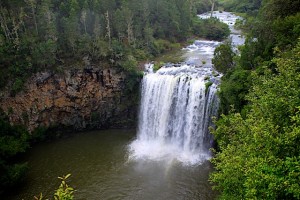Dorrigo is a little gem of a town. Not that it has any opal or diamond mining that I am aware, simply because its a little different from some of the others towns I’ve been visiting recently. Firstly there is it’s size – its just right! Its easy for the day tripper to cover the entire town centre with enough to keep them interested – although as its the wettest place in New South Wales, you’d best take your umbrella.
But lets take a step back, driving into Dorrigo is worthy of a note on its own. I stopped just outside the town to take a self portrait photograph by the town signpost before venturing a bit nearer the town centre. As I drove along I noticed a railway carriage, then another and another until countless railway carriages in varying states of repair were visible. I then drove a little further only now steam locomotives started coming into my vision, but in the distance. I then started turning up several side streets in Dorrigo to see how I could get closer. I found one such street alongside green fields and a few metres away, along with some cattle these great artefacts of travel in times gone by were before me.
The railway memorabilia on display is quite an amazing site. Apparently all these carriages and trains belong to the Dorrigo Steam Railway and Museum Limited who claim to have the largest collection of preserved railway vehicles and memorabilia from the various Government and private railways of New South Wales. It is one of the most comprehensive railway collections in the world, with exhibits ranging from 1855 to the present day. The only sad part about all of this is that the museum is not yet open to the public and on face value seems a long time coming with over $7 million of funds raised since 1973.
Whilst I stood taking in the 65 locomotives and the various rolling stock before me I was pleased to see the Google Street Car heading straight for me. Hopefully before too long I’ll be able to give a link to Street View showing me in Dorrigo.
Time was still early but I had yet to eat breakfast so I headed to a small bookshop come cafe in the town. The mixture of food and books combines two of my favourite hobbies – eating and reading – and I was pleased to grab a couple of bargains from the book shelfs as well as settle my appetite.
On paying for my purchases I noticed a copy of the local “Don Dorrigo Gazette” on the counter and asked if I could buy a copy as the publication had such an old fashioned feel about it. Sadly this copy was not for sale, but I was directed to the local Spar where I paid my $1 in return for a fresh copy of the local rag.
Now a copy of the “Don Dorrigo Gazette” has to be seen to be believed. As the old joke goes, its black and white but read all over. With no illustrations to speak of, the layout takes you back to the 1950’s when newspapers were produced using a old letter-press process. This all got the better of my curiosity so I phoned the number at the top of the newspaper to find out some more. Despite the short notice I was kindly invited to pop into the newspaper office which lies up a narrow lane between a garage and another business.
As I walked through the door into the workings of the Dorrigo Gazette I was immediately taken back in time. To my right was a disused letter-press printer about to be restored, whilst to my left a flight of stairs that led to the office where the accounts were managed. Following a bit further to the right I notice an old fashioned printing press and then, up the far corner whirring away with a contented tone was a piece of equipment that frankly amazed me. Here, in this sleepy picturesque and friendly New South Wales town lies the only letter-press system still in regular use within the country – and maybe even the world.
Michael, the publisher kindly explained the workings of this device and the obvious love hate relationship he has with it. In summary the device has moulds for each letter of the alphabet. These moulds are then brought together through tapping away at a keyboard. Once one line of text is complete molten lead is poured into these miniature moulds and a cast with raised lettering is produced for one line of text. The moulds are transported back to the top of the machine where it automatically sorts them ready for the next line of text to by typed.The raised characters filed away ready for proof reading and if accurate, printing.
It is, compared to todays word processing a slow and tedious process – especially when things don’t go well. A letter dropping in the wrong bin for instance when being sorted results in a typo and a lot of work to resolve. However, the unique end result is shared each week in a print run of about a thousand copies.
Before moving on, I did call in an the Dorrigo Dangar Falls and with all the recent rainfall were putting on quite a show for me.



That railway collection is definetly the greates I have seen. It is an absolute travesty that they don’t even let you in to wander around the trains. I would happily pay the entry fee knowing it would go towards building a proper museum.
Great to read your account, I was born in Dorrigo and miss it dearly 🙂